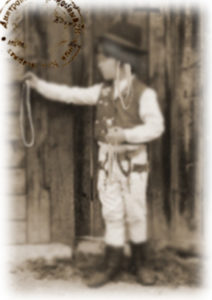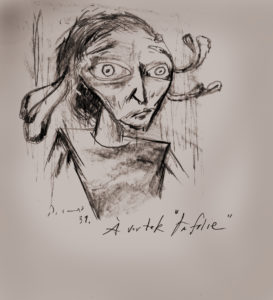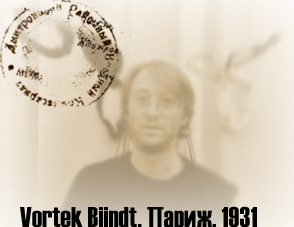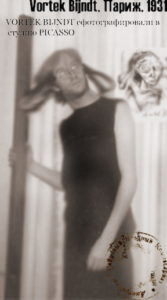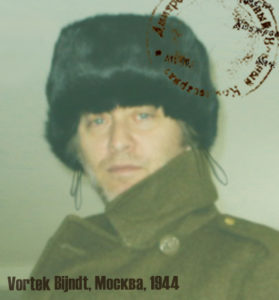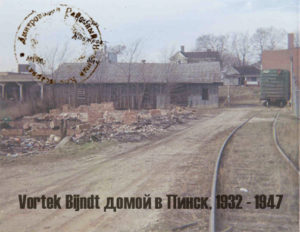Vortek Bijndt lived in Paris during the beginnings of the modern art movement, around the 1930’s. He was basically a very strange person that attempted to communicate to the world through hanging large rubber bands on his ears and moving his head in strange ways. This obsession with rubber bands stretches itself into his “works of art” that are sculptural in nature and made of metal, wood and primarily, rubber bands. These sculptures employed a unique form of counter-physics, or better known as ‘applied counter-physics’ that at times would tend to break, resulting in injuries and a few deaths. The Soviets eventually found out about the lethal qualities of his sculpture and confiscated them for their secret uses, thus plunging Vortek Bijndt and his creations into historical obscurity. The United States’ military eventually became interested in Bijndt’s sculpture, as well and attempted to utilize them to promote environmentally friendly weapons.
His work blossomed during Paris’s art epoch of the late 1920’s. He was considered insane by many of his contemporaries, as the concept or term of conceptual art was not even invented until nearly 40 years later, in 1967. But some felt he was far ahead of his own time and thought one day would be heralded as a true innovator. Gauging by our contemporary high standards in art, philosophy and aesthetics he should be hailed as a powerful artistic genius – but due to the extreme danger of this form of art, it has been decided to keep most of the pieces hidden and show only the more benign works.
Hungary
Vortek Bijndt was born in Békéscsaba, Hungary on May 15, 1895. His father was a worker in a rubber band factory.
(Vortek at age 7 in Békéscsaba, Hungary, as he is offering to share a rubber band)
Paris
Vortek arrived in Paris in the summer of 1926 and remained there until his abduction by the Soviets and sudden disappearance in 1932.
He was considered by his peers to be a very “odd” person or as mentioned earlier, insane, since he attempted to communicate to the world through the action of hanging large rubber bands on his ears and moving his head in strange ways. Some of his “works of art” are simple, primitive drawings and some are sculptural in nature.
For Bijndt, these sculptures were experiments of ‘vibrational harmonics’ using various elastics and components of glass, wood and metal, that when properly assembled and combined with his unique bio-electrical signature, would strangely resonate. As witnessed by people watching him at work, it was said that they would sometimes hear faint oscillating, humming sounds and see dim glowing radiation emanating from his sculpted objects when he was physically near them. It isn’t clear or understood what was actually happening or specifically what Bijndt was looking for or trying to accomplish. Questions at the time were asked; Did these objects have medical application? Or were they concerned with some new form of energy generation. Or perhaps did he just simply enjoyed making them and liked their harmonics…? We will never know as he was forced to use his elastomeric vibrational harmonics toward a darker purpose.
Picasso and his friends
During his brief stay in Paris, which lasted from 1926 through 1932, Vortek somehow became acquainted with Braque, Picasso and, some might say, he was a friend of Yves Tanguy, though it’s unclear why.
He was often seen wandering the streets of Paris alone at night. On various occasions, operatives of the newly formed Soviet regime, stationed in Paris at the time, followed him. They seemed curious about his sculptures and the energy they possessed and emitted.
Picasso had done a few sketches of Bijndt in his studio that went missing soon after Vortek’s abduction to the Soviet Union. It is believed that the officers in charge of Bijndt stole them. Poor photographic records of these drawings were made at the time and still exist.
(Portraits of Vortek Bijndt by Picasso, dated 1931 and 1932)
(photos of Vortek Bijndt in Picasso’s studio, dated 1931)
Aesthetic Weapon Discovery
In the newly formed Soviet republic a secret branch of the military was in desperate need of advanced weapons in order to sustain control over their people. In 1932, Stalin eventually discovered the lethal capacity of Bijndt’s sculptures while Bijndt was in a cafe in Paris.
The following is an excerpt from a declassified statement by a KGB officer, Mineff, S. (Vanini), He and 4 other agents were assigned to follow and observe Bijndt while in Paris.
January 8th, 1932 – 21:53. (From a translated declassified KGB document)
I followed Bijndt from his studio. He walked rapidly to the Port De Lilas and then took the bus to Bastille. He then walked to the small café at No. 2 rue St Paul. He sat at a table in the corner near the window as the other tables were either occupied or had chairs placed upon them. I sat in the back of the café and hid behind my newspaper to observe him. The waiter approached him to take his order. He pointed to the menu and then waved his head moving his elastics around as he seems to do when communicating with people. The waiter seemed surprised by this action and stared for a moment, scowling at Bijndt, then walked off shaking his own head. A few minutes later the waiter returned with a soup and set it down before him. Bijndt began to eat his soup hunched over with his elastics drooping on either side. He then sat back and removed a wooden box the size of a pair of shoes from his satchel and placed it on the table. He seemed to deliberate over it for a moment. He opened it and took out a small object that was constructed of gleaming metal, glass, plaster and wooden forms bound together by tightly woven bands of elastics. This object was of a form that I had never seen before. It was similar in nature to other items in his studio, but yet had more angular forms and sharp protrusions that randomly extended from its core. He took out another, smaller box and placed it on the table. From it seemed to be a few tools and elastic bands. He began to work on the object. His fingers were rapid and nimble. His expression was blank as he stared at the object. I heard a dim high pitched sound emanating from the object and some of the pieces began to take on a faint bluish glow. For a moment there it looked like he was fading. I mean, it seemed he was, for lack of a better word, becoming blurry. It was then almost as if he shifted his position a few centimeters to the left in an instant without seeming to try to move. I rubbed my eyes, because when he shifted his position, he seemed to be, just for an instant, in the two separate places simultaneously. It is difficult to describe, but when he shifted to the left, for that instant there were two of him that seemed to be merged with each other and then the one of him on the right suddenly faded and vanished completely. I craned my neck to get a better look without being obvious.
I noticed a small crowd was gathering outside the window to watch him. Then one by one they came into the cafe to observe him at closer range. People within the café became aware of him and also began to watch him. His pace began to quicken. His head began to swing from side to side, waving the elastic bands around. He seemed completely oblivious to the people that have now surrounded him.
Some people in the crowd began to make scornful comments that he seemed either to ignore or not hear. The comments became insulting jeers directed at his elastic bands hanging from his ears. More people began to yell insults at him. Suddenly the crowd started to look like a mob. I gripped the handle of my pistol and readied myself. Then one person yelled something insulting at him gesturing to the object on the table. Bijndt stopped working and stared at him, his face expressionless. I removed my pistol from its holster. And placed it on the table under my newspaper, safety off.
Suddenly one of the people took a swipe at the object, and knocked it over onto its side. What followed was incredibly strange, resulting in chaos and confusion. From what I could see, a dim bluish flash emitted from it when it hit the table, then pieces of it began to break off and fly in different directions at frightening speeds. The window in front of Bijndt suddenly shattered, exploding shards of glass onto the crowd in the street. Some of the people in and around the cafe gripped their faces, heads and bodies as pieces of the object ricochet around the room. One man’s ear vanished in a spray of blood and another man dropped to the floor gripping his bloodied neck and then became lifeless. A small projectile tore through my hat cutting the side of my head as I dove to take cover under the table.
The pieces stopped flying almost as fast as they started. Someone yelled something and in an instant the mob grabbed Bijndt and fists started to fly. As I was about to fire off a round into the ceiling someone threw him into the street through the broken window, then someone else threw out the rest of his belongings after him, including the object which let loose a few more pieces into the night breaking glass across the street. The mob was screaming obscenities at him as he picked himself up and collected his various belongings and limped off into the night toward the river. I slipped out of the café, passing through the mob and discreetly followed him at a safe distance. He arrived at the river and just stood there. I motioned to Steppov and Zaitzev who were waiting in the shadows near by to prepare to swim. Standing at the Pont Marie, looking into the Seine he threw the object into the black water and then turned and walked away. I waited until he was down the quay a good distance and then I ran down to the bank and fished the object out of the river, wrapping my overcoat around it.
I motioned for STEPPOV who was a few hundred yards back to stay on Bijndt. I then ran the object to Shpigelgas who’s instruction it was to immediately bring it to Stalin.
END OF DOCUMENT.
As mentioned in the document, Mineff secretly met with Mikhail Shpigelglas, an agent sent by Stalin to France. He was ordered to set up an observation station hide-out across the street from Bijndt’s studio in a pork sausage factory. Shpigelglas was appointed by Stalin and sent to France to seek out a way to kill Trotsky. After the cafe incident, it was Shpigelgas’s idea to present a sculpture of Bijndt’s to Trotsky as a gift by a “secret admirer” in an attempt to assassinate him.
While Bijndt was walking depressed, aimlessly through the city, Shpigelgas broke into Bijndt’s studio and stole a small sculpture, carefully boxed it and sent it to Trotsky by Currier. The attempt at his life failed because the sculpture presented was improperly assembled due to poor quality of the rubber. The sculpture simply fell apart in Trotsky’s reading room with injuries sustained only by his cat that had been playing with parts of it. This event, despite the failed assignation attempt, however marked a turning point that the direction Bijndt’s art would take. For the first time, his art would be seen as a weapon.
Pinsk
It is now known through recently surfaced declassified KGB documents, that four days after the cafe tragedy, Bijndt was secretly abducted along with his equipment and sculptures, from his studio/apartment in Pre St. Gervais, by Mineff and a small group of other KGB agents (names unknown) and was brought to Pinsk, a city that was once part of the former Soviet Union. The documents say that he had been “convinced” to live there from 1932 – 1947, the year of his death, under threat of the removal of all rubber bands from his ears.
(photos of Vortek BIjndt, dated 1944 and 1946)
Weaponized art – or aesthetic weapons
Throughout those difficult years he was forced to create his sculptures for the Soviet military machine, developing this new form of lethal “sculpture” or known to his superiors only as “aesthetic weapons” under the project codenamed: “Джек в коробке” Or “Jack-in-the-box”
Throughout World War ll, under the cloak of secrecy, he worked on these sculptures in covert military facilities in Moscow, developing new methods to make even more lethal and frightening art.
Before and after the war, he lived and worked in an unmarked warehouse outside of Pinsk until his death in 1947 at the age of 49. Throughout that time he made frequent visits to military facilities in Moscow.
Vortek Bijndt’s Death
His death came suddenly at 23:09, November, 9th, 1947 while constructing a sculpture. The declassified document states that he was beheaded by a projectile that shot off of one of his sculptures into his face – That was the official government story.
Three months later an anonymous letter with top level secret KGB documents about Bijndt and a film reel was sent to his son, Vortek Bijndt Jr., stating that his father’s death was not an accident. The letter said that Bijndt refused to cooperate with the KGB when he was ordered to create destructive sculptures meant to kill people, that Bijndt was threatened and was told his son would be in danger if he did not cooperate. Four KGB officers were sent to to Bijndt’s studio to bring him to a facility where he would be “convinced” to continue with the production of the sculptures. Something occurred there resulting in the deaths of Bijndt and three of the four officers. A note was found on his body that seemed to say he was feeling helpless and cornered with no way out and that he would sabotage this potentially deadly sculpture he was working on so as to not harm others.
All of Vortek’s work in the weapons factory was continuously filmed. This surviving film reel shows the tragic moment of his death. The following is a description of that sequence in the film :
The film shows the room where Bijndt creates his sculptures. The large warehouse room is filled with piles of metal, wood, glass, plastic forms and massive elastic loops of various sizes hanging on all the available walls. Bijndt walked up to the camera and spoke directly to the lens saying:
(the following text is translated from his broken Russian)
“My name is Vortek Bijndt. I like rubber bands. They are my friends. They help me do things good. I make sculpture here of my creation with rubber band. I make energy with rubber band.”
Suddenly, on the left of the view a door bursts open and four KGB officers run into the room. Two of them kneel and aim rifles at Bijndt, a third stands and removes a folder from his overcoat, opens it and removes papers and the fourth stands guarding the door. The officer with the folder shouts orders at Bijndt to come with him, which Bijndt seems to ignore. Bijndt turns and slowly walks over to a massive rubber band and metal sculpture at the far end of the room. The officer follows continually shouting at Bijndt. Bijndt ignores them as he starts to adjust something on the sculpture. The sculpture began to brighten and glow as he manipulated the various pieces. As that occurred his entire body started to fade and blur and then there was simultaneously two of him, though both faded and semi-transparent, standing in the nearly the same place. The soldiers stopped shouting and stared at him, shocked. There were now two distinct forms of Bijndt present in front of the sculpture, both seeming to be unaware of the other and both subtly fading and blurring. Each one was independently working on the sculpture. Suddenly pieces began to break off from the sculpture smashing the right side form of Bijndt in his face exploding the back of his scull toward the camera. His headless body crumpled to the floor. The form of Bijndt on the left simultaneously grabbed his head and then became fully opaque then glowed brightly and then vanished into the glow of the sculpture.
At that instant a fog of dust and debris engulfed the sculpture as hundreds of pieces disengaged and fired around the room shattering the windows, the cinder block walls and ceiling lamps but mysteriously missing hitting him, though at such close range. The piles of material around the room flew apart as they were struck by the high velocity projectiles. Some of the pieces struck the officer with the folder and the two officers with the guns, killing them instantly. The officer at the door turned and ran out of the room. The lens of the camera was struck and shattered as the film ended abruptly.
After the cold war set in, these “aesthetic weapons” were attempted to be further developed for the use as “public art” in key western cities but that program was suddenly halted after Bijndt’s death due to a lacking of his unique imagination and electro-biochemistry, thus, sparing the lives of countless innocent bystanders and art lovers.
During the cold war, a secret branch of the United States military also became interested in Bijndt’s “weaponized” sculptures. But, again, as Bijndt had been killed and his genius tragically lost, the secrets of his work and his unique understanding of his own intuitive form of physics had, as well been lost forever.
The discovery
Since the fall of the iron curtain, several of Bijndt’s sculptures and drawings recently surfaced in flea markets outside of Pinsk.
As there is again a rise in a Soviet-like establishment in the eastern block, a new interest in the art of Vortek Bijndt seems once again to be growing under the cloak of secret branches of the Russian military. A sad consequence of this fact is that the rubber trees in the Amazon are now being burned at an alarming rate by “unknown” western government alliances.
In 1992, just after the fall of the Soviet Union, Vortek Bijndt’s son, Vortek Bijndt Jr. who resided outside of Pinsk, found these historical gems while visiting these flea markets. With keen forethought and understanding of the volatility of the former Soviet union and the government to which it now became, he collected everything he could find having to do with Vortek Bijndt and sent it all out of the country to Slawveldid Bijndt, a cousin of his who until 1997 resided in a small town outside of Paris. He did this in an attempt to keep their dangerous secrets from getting into the hands of the rising Russian military. Rumors spread that soon after he sent everything, he was killed by former KGB agents by an overdose of sodium-pentothal when he wouldn’t disclose the location of his father’s sculptures. Slawveldid is now the sole proprietor of these works and being the only Bijndt left, now he alone intuitively understands the secrets of Vortek Bijndt’s art.
Vortek Bijndt spin-off’s
Recently a splinter group of eco-terrorists disguised as “conceptual artists” found the location of Slawveldid and his collection of Vortek Bijndt’s sculptures and managed to photograph some of these pieces before they were frightened off by the high impacts of elastic bands set off by Slawveldid.
With poor results yielded in attempting to replicate these sculptures, as the only reference they had were blurred photographs, these ecco-terrorists are now attempting to produce these works of art for their own terrorist activities which include protesting the destruction of the rain forest. Ironically, however, the creation of these sculptures requires the destruction of rubber trees.
“This is terror”, they claim, “without the harmful ecological consequences that result from explosions.” Luckily, they are so far failing, for the same reasons as as everyone else: Bijndt is gone and so is his genius. But, these “copy-cat” attempts to replicate Bijndt’s art do occasionally show up in conceptual art galleries and museums curated by unsuspecting and ignorant gallery and museum directors across the country with only minor incidences of physical harm to the viewers, since the major force of Bijndt’s physics is no longer available.
Sadly, the bulk of the harm to society mostly occurs to the standards of culture and aesthetics since these “copy-cat” weapons are often confused with conceptual “art”.
Safety first
In an effort to keep the world safe, inspired by Vortek’s integrity and dedication to safety and the well being of art lovers, Slawveldid and his collection of Vortek Bijndt’s art had since moved to an undisclosed location. He is in the process of setting up this website in order to educate the world of the dangers of the movement of aesthetic weapons and the gross misuse of his cousin’s art, but, mainly to keep his cousin’s name alive and to try to preserve the purity of his genius.
© Slaveldid Bijndt
This is intended to be a fake documentary or “mockumentary” of a fictional person named Vortek Bijndt, a satire on the conceptual art movement which is prevalent in today’s artistic culture. The documentary would be played on a video in a real art gallery installation of sculptures, drawings and photos that were created by Vortek Bijndt. The creations would be real and created for the exhibition and the film.
